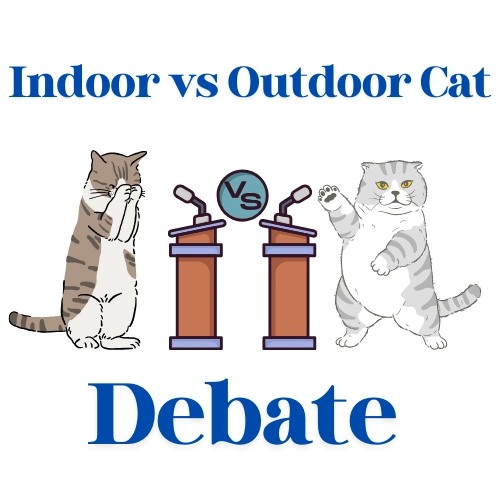Key Takeaways
Indoor vs. Outdoor Cat Debate: There is no one-size-fits-all answer; both choices have pros and cons depending on individual circumstances.
Indoor Cats: Generally safer, live longer, and avoid outdoor risks like traffic, predators, and disease but require proper enrichment and a well-balanced environment.
Outdoor Cats: Benefit from natural behaviors and exercise but face greater risks, including injury, disease, and impact on wildlife.
Research & Bias: Studies support both perspectives, but bias can influence interpretation—critical analysis is key.
Compromise Solutions: Options like catios, leash training, and supervised outdoor time provide enrichment while minimizing risks.
The debate over whether cats should live indoors, outdoors, or a mix of both is ongoing and highly polarizing. Owners, veterinarians, wildlife conservationists, and animal welfare organizations often have strong opinions, with research offering insights that support multiple perspectives. There is no one-size-fits-all answer. The decision depends on factors like safety, mental and physical health, predation, enrichment, geographical location, and personal beliefs. While certain circumstances may clearly favor one choice over another, each cat-owner must carefully evaluate the risks and benefits.
Currently, pet owners in the United States keep 63% of domestic cats entirely indoors. This number continues to rise as indoor living gains popularity. However, many cat owners hold opposing views. Despite the passionate debate, one key point remains: whether advocating for indoor or outdoor living, all parties involved share a deep love for animals and strive to make the best choices for their welfare.
Proponents of outdoor access argue that it allows cats to express natural behaviors, a core component of the Five Freedoms (freedom to express natural behavior) and the Opportunities to Thrive (opportunity to express species-specific behavior). Additionally, outdoor-cat advocates highlight the benefits of choice and control, which can lead to improved mental wellbeing.
Conversely, those who support keeping cats indoors emphasize several advantages aligned with the Five Freedoms and Opportunities to Thrive. Indoor environments allow for controlled diets, ensuring freedom from hunger and thirst and the opportunity for a well-balanced diet. Comfortable homes provide freedom from discomfort and the opportunity to self-maintain in that well-balanced environment. Indoor safety measures prioritize freedom from pain, injury, and disease and the opportunity for optimal health. Advocates of indoor living may also focus on enrichment strategies to facilitate natural behaviors and positive mental experiences. Many also believe that keeping cats indoors prevents fear and distress by reducing exposure to external dangers.
However, it is important to recognize that the arguments presented above reflect the beliefs and reasoning of advocates rather than purely evidence-based conclusions. While these perspectives highlight key concerns and benefits, they do not necessarily reflect definitive scientific findings. As we transition into a more research-driven discussion, it is crucial to analyze empirical data to better understand the broader implications of indoor versus outdoor living for cats.
The Case for Indoor Cats
Many veterinarians and animal welfare groups advocate for keeping cats indoors due to the numerous risks associated with outdoor exposure. The American Veterinary Medical Association (AVMA) advises owners in the United States to house their cats indoors. This is all to mitigate risk. These risks include:

Safety Risks: Road traffic accidents are a leading cause of death and injury for outdoor cats. This is the number one reason why indoor-cat owners decide on this particular arrangement. They also face threats from predators, poisoning, and even human cruelty. 84% of indoor-cat owners express that they are concerned for their cat’s safety if they were to roam outdoors.
Disease and Parasite Exposure: Outdoor cats are at a higher risk of contracting feline leukemia virus (FeLV), feline immunodeficiency virus (FIV), rabies, and various parasites.
Longer Lifespan: Studies suggest that indoor cats live longer on average, with outdoor access reducing longevity by up to two years.
Wildlife Protection: Domestic cats are responsible for significant wildlife predation, affecting bird, mammal, and reptile populations. This impact has led to efforts to keep cats indoors to reduce ecological harm.
Risk Management Control: Many potential risks identified in research can be managed by the owner, whereas unsupervised outdoor cats face increased dangers beyond their control. A 2014 research article found that cat owners who actively engage in play and interaction with their cats report fewer behavioral issues. Regarding obesity and other health concerns, experts suggest that inadequate indoor enrichment opportunities provided by owners often contribute to these issues.
Challenges of Keeping Cats Indoors
While keeping cats inside eliminates many external dangers, it also presents its own set of concerns. Indoor environments are not without their own risks to cat welfare:
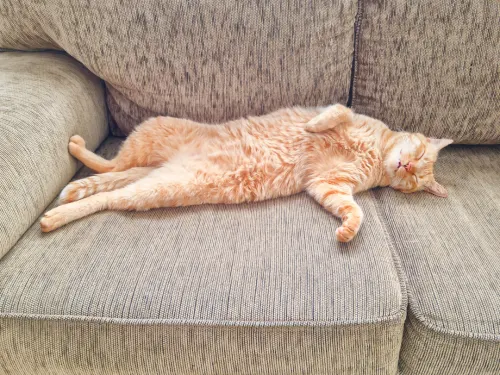
Obesity and Health Issues: Indoor cats may be more prone to obesity due to reduced physical activity and an increased intake of high-calorie foods, especially if portion control and enrichment activities are not properly managed. They may also have higher rates of hyperthyroidism, exposure to in-home poisons, and poor air quality. Providing a proper well-balanced environment aids not only in promoting health, but also establishing necessary enrichment opportunities. Include shelves and vertical spaces like climbing posts, cat condos, and windowsills. Other objects include boxes, cat tunnels, paper bags, etc. These allow cats to engage in physical activity, exploration, and investigation. The vertical spaces also expand the territory allowing cats more opportunities for hiding and resting, which are critical components of providing a well-balanced environment.
Behavioral Issues: Some studies suggest that indoor cats exhibit more stress-related behaviors, including inappropriate urination, aggression, and furniture scratching. Though some research suggests, “providing enrichment opportunities that engage the cat in play, cognitive, social, and hunting behaviors can reduce unwanted behaviors, such as inappropriate urination and aggression towards owners.”
Need for Enrichment: Research states, “Addressing environmental needs is essential (not optional) for optimum wellbeing.” This should be done proactively. Indoor cats thrive when provided with diverse enrichment options, including climbing structures, interactive play, puzzle feeders, and environmental variety. To replicate natural behaviors such as stalking and hunting without harming wildlife, owners can scatter food, hide treats or toys, and create engaging setups that encourage innate feline instincts. Daily interactions demonstrate the importance of human-feline bonding, requiring more time commitment from owners. But owners must appropriately manage these enrichment opportunities and the overall environment.
Prior Outdoor Lifestyle: Cats that have previously had outdoor access may struggle with transitioning to an indoor-only lifestyle, according to some perspectives. Researchers need to conduct further studies to fully understand the potential effects of this transition on a cat’s behavior, health, and overall wellbeing.
The Case for Outdoor or Indoor-Outdoor Cats
Some cat owners believe that allowing cats outdoor access is crucial for their wellbeing. Though risks are present, some research suggests that outdoor exposure may offer potential benefits to consider. The benefits include:
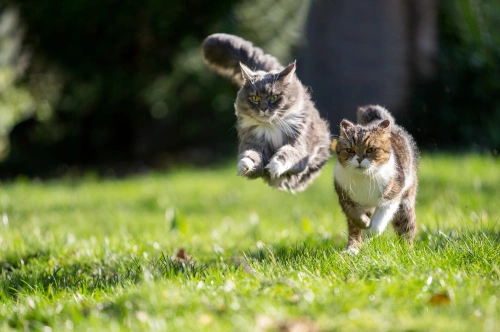
Expression of Natural Behaviors: Outdoor environments offer more opportunities for hunting, climbing, and exploration, which some argue are essential for a cat’s mental and physical health. The primary reason outdoor cat owners choose to let their felines roam is their belief that it enhances the cat’s mental wellbeing.
Increased Physical Activity: Outdoor cats often get more exercise, which may reduce obesity risks. Cats can travel several miles in a day. They also climb, jump, and pounce. This provides physical conditioning.
Reduced Behavioral Problems: Some evidence suggests that access to the outdoors can decrease frustration, boredom, and stress-related behaviors in cats including aggression, inappropriate potty use, urine marking, and furniture scratching.
The Risks of Outdoor Life
Despite these potential benefits, pet owners should not overlook the risks of outdoor access:
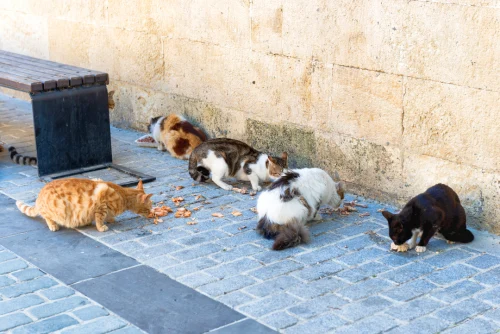
Increased Exposure to Disease and Parasites: Outdoor cats are more likely to encounter infectious diseases and parasites. One meta-analysis of 21 scientific studies concluded outdoor cats are 2.77 times more likely to become infected with parasites compared with indoor-only cats. The importance of staying up-to-date on all core and appropriate non-core vaccinations is critically important. It is also critically important to understand that vaccines are not 100% effect and there is still a risk of infection, though a much smaller one than an unvaccinated cat.
Higher Mortality Risk: Free-roaming cats face a greater likelihood of injury or death due to traffic, predators, and human-related dangers. Road traffic accidents are a major concern. 45% of cats, or nearly 1 in every 2 cats outdoors, cross the street while roaming. 87% of all trauma events for cats are road traffic accidents. Poisons are another potential risk as research has found 36% of outdoor cats ingest liquids not purposely provided to them by their owners or caregivers, which means they may accidently consume poisons. This can include antifreeze, pesticides, insecticides, etc. Beyond liquid toxins, cats are also at risk of poisoning through their natural hunting instincts. When they catch and consume rodents, they may inadvertently ingest rodenticides used by humans. This accidental exposure can be fatal, making it a serious risk for outdoor cats.
Lost and Stray Cat Populations: Outdoor cats face a significant risk of becoming lost, which can lead to them becoming part of the feral cat population. In fact, the United States has a challenging feral cat overpopulation issue; therefore, managing this risk is vitally important to help minimize the number of stray cats. The growing feral populations can present challenges for both animal welfare, wildlife conservationists, and local ecosystems. Many shelters or veterinarians take in lost cats, but often, these cats don’t return home. We recommend reading our blog on microchipping for more details regarding the significant odds against cats returning home. For quick reference, cats not microchipped are usually returned to their owner only 1-5% of the time. Microchipped cats have been shown in research to be 21x more likely to be returned home than non-microchipped cats. In Maine, the overall cat return-to-owner rate is about 5%.
Wildlife Impact: Outdoor cats can contribute to significant wildlife losses, including an expected 63 extinctions. A systematic review of 332 studies found cats have a negative impact on wildlife. In fact, 89% of the studies came to this conclusion. However, different groups analyze data through varying perspectives. This debate is often influenced by preexisting biases, with individuals interpreting data in ways that align with their existing beliefs; known as confirmation bias. However, a thorough, unbiased analysis of research and methodology confirms that cats do impact wildlife. This does not mean every cat in every environment poses a significant threat. Research indicates that 44% of outdoor cats hunt, meaning that nearly half do not. With that said, don’t assume that your outdoor cat doesn’t hunt local wildlife. Only 23% of prey items are brought home, which may lead to the mistaken belief that a cat is not impacting local wildlife.
Human Impact: Outdoor cats face a higher risk of contracting diseases and parasites, which in turn can pose health risks to humans. Cats can bring home some infections that are zoonotic, meaning they can transmit them to people. One example is Toxoplasmosis, caused by the parasite Toxoplasma gondii. In severe cases, Toxoplasmosis can lead to damage in the eyes, brain, and other organs. Pregnant women and their fetuses are particularly vulnerable, as the infection increases the risk of preterm birth, stillbirth, and miscarriage.
The Need for More Research: Understanding the Complexities of Indoor vs. Outdoor Cats
Despite decades of research on indoor and outdoor cat welfare, there remains a strong need for further study. Many research findings come with limitations that must be considered when drawing conclusions. In some cases, it may be best to withhold judgment until more comprehensive studies provide clearer insights. For example, much of the research on the risks of keeping cats indoors is conducted in shelters and veterinary settings rather than in homes. This makes it challenging to generalize findings to household environments.
A common belief is that indoor cats are more prone to obesity than their outdoor counterparts. This assumption seems logical, as indoor cats tend to eat more and consume higher-calorie food. They may also have fewer opportunities for physical activity. However, research presents a more complex picture with unanswered questions. In the United States, 28.7% of cats are classified as overweight, and 2.2% are obese (remember 63% of US cats are indoor-only). In New Zealand, where 95% of domestic cats have outdoor access, the statistics are similar—21.9% overweight and 2.6% obese. This raises an important question. If outdoor access were a major factor in preventing obesity, why are the rates so comparable? The data suggests that factors beyond indoor versus outdoor living may contribute to feline obesity. This highlights the need for further research to draw clearer conclusions.
Finding a Middle Ground: Alternatives to Full Outdoor Access
Cat owners who want to balance safety with enrichment can choose controlled outdoor options that mitigate risks while allowing for stimulation:
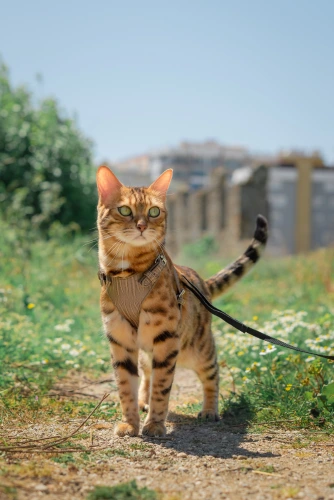
Catios and Enclosures: Secure outdoor spaces provide fresh air and natural sights without the dangers of free roaming. Some research indicates a significant positive effect on overall owner and cat quality of life. The American Association of Feline Practitioners (AAFP) and the International Society of Feline Medicine (now known as the International Cat Care Veterinary Society) state, “If possible, pet cats should have free access to safe places outdoors, which is their natural environment. An outdoor enclosure protects the cat from injury and from contact with predators and with free-roaming cats, which may increase the risk of infectious disease exposure.”
Leash Training: Some cats are trained to walk on a harness and leash, allowing them safe outdoor exploration under supervision. The AAFP position on leashing a cat for outdoor exploration states, “Leash-walking is another safe option, as long as the cat has been positively trained to leash and halter, and leash-walking is loose, allowing the cat choice as to where it wants to walk.”
Window Perches and Screened Porches: These allow cats to engage with their environment while staying protected. All of the above options allow for visual (sight), auditory (sound), and olfactory (smell) enrichment.
A Pet Sitter’s Perspective
At Burnell Pet Care and Education, we prioritize the safety of the pets we care for. When looking for a pet sitter, it’s essential to find one whose approach and policies align with your views. Our policy is to keep cats indoors while under our care to minimize acute risks. Indoor hazards tend to be more chronic, while outdoor dangers, such as traffic accidents or predators, are immediate. That said, we respect each owner’s decision and can provide guidance based on individual circumstances. Additionally, we ensure that indoor cats receive proper enrichment using principles from the Five Freedoms and Five Opportunities to Thrive.
Conclusion: The Decision Rests with Responsible Ownership
Indoor/Outdoor Cat Debate
“Our current state of knowledge does not answer the question as to whether strict indoor living is preferable to outdoor access, and there are risks and benefits associated with both options. Each case should be assessed individually and the wellbeing of the cat, the owner and the environment should be reassessed as necessary.”
-Margie Scherk, DVM, Dipl. ABVP
There is no universal answer to the indoor vs. outdoor cat debate. While research increasingly supports indoor living for longevity and safety, it also acknowledges the importance of enrichment and natural behaviors. Any concerns about potential risks to indoor cats including behavioral issues, boredom, and weight issues can often be offset by enrichment and owner-cat interactions. If structured and managed appropriately, “adequate environmental enrichment can facilitate the expression of the species-specific behaviors necessary for happy, healthy cats.” Owners must critically evaluate their unique circumstances, including their cat’s temperament, environment, and available resources.
The trend toward keeping cats indoors in the United States has been growing steadily since the 1950s. It is expected to continue. However, this does not mean outdoor cats will disappear entirely. Regardless of personal choices, it is important to acknowledge our own biases. If there’s one key takeaway from this article, beyond providing insights into cat care, it’s recognizing that everyone has biases. However, differing opinions do not necessarily make someone wrong or bad, and fostering understanding is essential.
The 2020 book Cats and Conservationists: The Debate Over Who Owns the Outdoors effectively captures the core message we aim to convey. The book states, “In short, listening requires framing the conflict not as a fight between good and evil, but rather as a disagreement between people with good intentions, all of whom sincerely believe that their positions are well-supported by science, morally sound, and practically effective.” Responsible pet ownership involves making informed decisions that balance a cat’s wellbeing with potential risks. At Burnell Pets, we encourage using the Five Freedoms and Five Opportunities to Thrive as a guiding framework to help determine whether outdoor access or an indoor environment is the best choice for your cat. Whether indoors, outdoors, or somewhere in between, providing a stimulating, safe, and loving environment is what truly matters.
